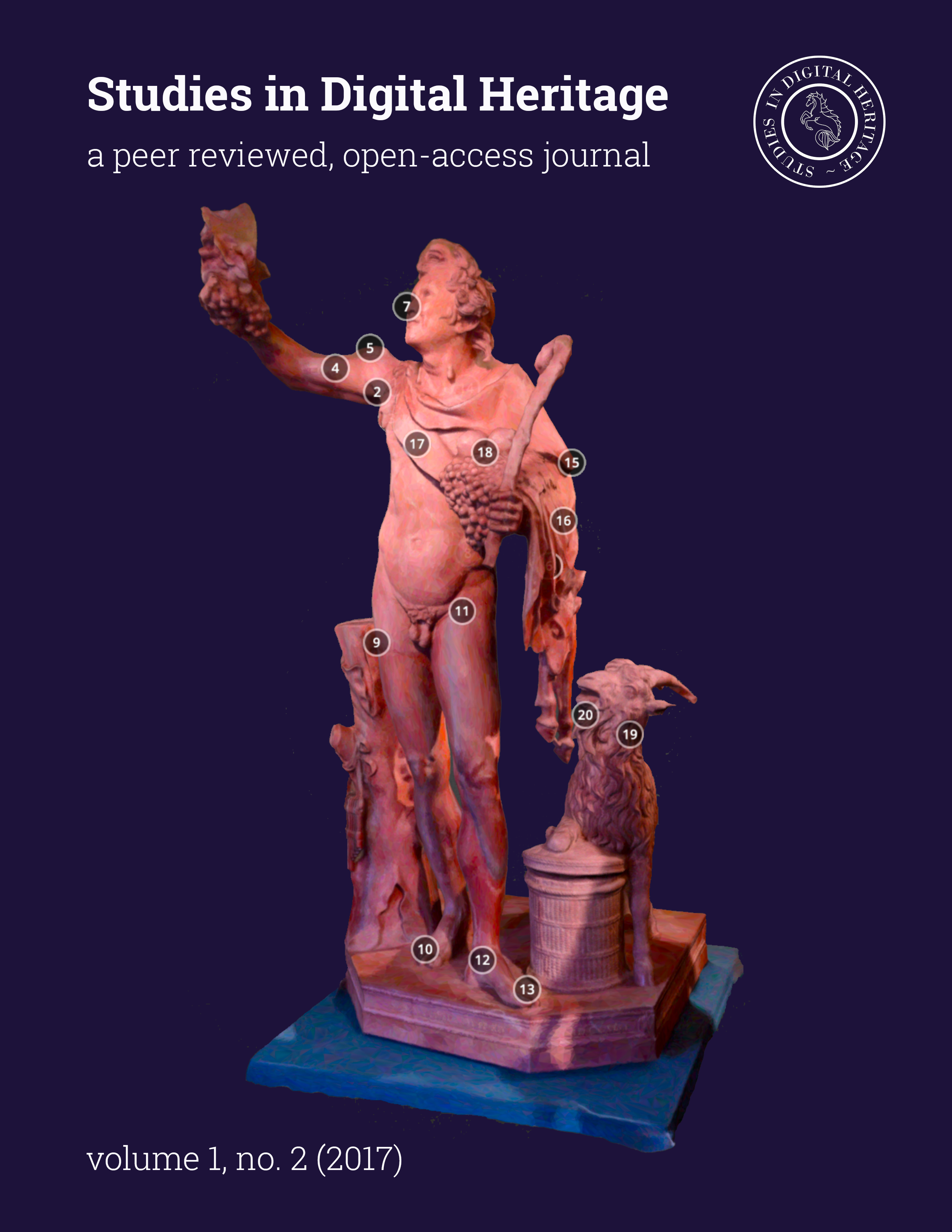Archiving Archaeological Research Data - On Requirements, Objectives and First Experiences from a German Respectively Saxon Point of View
Main Article Content
Abstract
Preserving digital data over long times is an ambitious task. While most analogue documents are best stored without touching them, digital data need permanent care and curation. Regarding some differences between analogue and digital data - lifecycle, complexity, functionality and so on - it can be realized, that digital archiving is a new challenge.
This paper will deal with requirements and objectives on archiving archaeological research data, as discussed in a working group of the Association of State Archaeologists in Germany (Verband der Landesarchäologen in Deutschland – VLA). Interesting themes of that discussions were “Archive Objectives”, “Worthiness of Archiving”, “Suitability of Archiving” and “Future Use Scenarios”. This paper will also deal with first experiences in building up a digital archive for archaeological research data in Saxony. This archive follows principles of “Open Archival Information System” (OAIS). It is based on professional software that has to be adapted to the special requirements of archaeological data like e.g. excavation documentation. OAIS defines six complex functions to be performed, e.g. data management and preservation planning. Preservation strategies are presented to give an idea on how to preserve content and function of archive material while systems are changing over time. This is an alternative to the idea, knowing file formats will solve all preservation problems.
Archiving is the most intensive and most expensive way to store data. But aren’t there any alternatives? This paper will address some small steps leading towards a proper archiving without using large budgets. Going such steps will help to reduce the risk of losing important digital information. Going these steps will also bridge the gap until proper preservation tools will be available at a reasonable price.
This article may be helpful for archaeologists that are about to build up an archive to preserve digital data for long terms. The presented concept of preservation strategies may be of interest for specialists on digital archiving.
Downloads
Article Details

This work is licensed under a Creative Commons Attribution-NonCommercial 4.0 International License.
From 18 May 2018, the contents of Studies in Digital Heritage are licensed under a Creative Commons Attribution-NonCommercial 4.0 International License (CC BY-NC 4.0). Our submitting authors pay no fee and retain the copyright to their own work.
How this works: to submit their work to the journal, authors grant Studies in Digital Heritage a nonexclusive license to distribute the work according to a CC BY-NC 4.0 license. Once an article is published, anyone is free to share and adapt its contents—provided only that they do so for noncommercial purposes and properly attribute the shared or adapted information. Details of these terms can be found on the Creative Commons website.
Download SDH’s full author agreement here
Studies in Digital Heritage will insert the following note at the end of any work published in the journal:
© [Year] by the authors. This article is an open-access article distributed under the terms and conditions of the Creative Commons Attribution License CC BY-NC 4.0 (https://creativecommons.org/licenses/by-nc/4.0/).
References
ADS. Archaeology Data Service. Homepage. Retrieved January 2017: http://archaeologydataservice.ac.uk/
ADS-G2GP. Guides to Good Practice. Homepage. Retrieved January 2017: http://guides.archaeologydataservice.ac.uk/g2gp/Main
ARCHES. Archaeological Resources in Cultural Heritage: a European Standard. Homepage. Retrieved January 2017: http://archaeologydataservice.ac.uk/arches/Wiki.jsp?page=The%20Standard%20and%20Guide%20to%20Best%20Practice%20in%20Archaeological%20Archiving%20in%20Europe
Archiving Group of VLA. Kommission Archäologie und Informationssysteme - AG Archivierung. Homepage. Retrieved January 2017: http://www.landesarchaeologen.de/verband/kommissionen/archaeologie-undinformationssysteme/projektearbeitsgruppen/archivierung/ DANS. Data Archiving and Networked Services. Homepage. Retrieved January 2017: https://dans.knaw.nl/en
DC. Dublin Core Metadata Element Set. Retrieved January 2017: http://www.dublincore.org/documents/dces/
DPC. Digital Preservation Coalition. Homepage. Retrieved January 2017: http://www.dpconline.org
DPH. Digital Preservation Handbook. Digital Preservation Coalition. Retrieved January 2017: http://dpconline.org/handbook
DROID. Digital Record Object Identification. The National Archives. Retrieved January 2017: https://www.nationalarchives.gov.uk/information-management/projects-and-work/droid.htm
DSA. Data Seal of Approval. Homepage. Retrieved June 2017: https://www.datasealofapproval.org
R. Göldner. 2016. Ein Erfahrungsaustausch zur Archivierung digitaler archäologischer Daten – Zusammenfassung 2015/16. Retrieved January 2017: http://www.landesarchaeologen.de/fileadmin/Dokumente/Dokumente_Kommissionen/Dokume nte_ArchaeologieInformationssysteme/Dokumente_AIS_Archivierung/Erfahrungsaustausch_Archivierung_201511_Zusammenfassung.pdf
R. Göldner et al. 2015. Ratgeber zur Archivierung digitaler Daten. Retrieved January 2017: http://www.landesarchaeologen.de/fileadmin/Dokumente/Dokumente_Kommissionen/Dokume nte_ArchaeologieInformationssysteme/Dokumente_AIS_Archivierung/Ratgeber_Archivierung_V1.0.pdf
R. Göldner. 2010. Preserving Digital Data Step by Step – Small Solutions for Small Institutions. In: Proceedings of the 14th International Congress “Cultural Heritage and New Technologies”. Wien: eBook Edition, 2010. Retrieved January 2017: http://www.stadtarchaeologie.at/wp-content/uploads/eBook_WS14_Part3_AT_1.pdf (pp. 117-125)
T. Gollins. 2013. Putting Parsimonious Preservation into Practice. Retrieved January 2017: https://www.nationalarchives.gov.uk/documents/information-management/parsimoniouspreservation-in-practice.pdf
T. Gollins. 2009. Parsimonious Preservation: Preventing Pointless Processes. The National Archives. December 2009. Retrieved January 2017: http://www.nationalarchives.gov.uk/documents/information-management/parsimoniouspreservation.pdf.
IANUS. Forschungsdatenzentrum Archäologie & Altertumswissenschaften. DAI. Homepage. Retrieved January 2017: http://www.ianus-fdz.de/
IANUS-IT. IT-Empfehlungen für den nachhaltigen Umgang mit digitalen Daten in den Altertumswissenschaften. DAI. Retrieved January 2017: http://www.ianus-fdz.de/itempfehlungen/
NDHA. National Digital Heritage Archive. National Library of New Zealand – Digital Preservation Programme. Homepage. Retrieved January 2017: http://digitalpreservation.natlib.govt.nz/about2/programme-overview/ NESTOR. Kompetenznetzwerk zur Langzeitarchivierung. Homepage. Retrieved January 2017: http://www.langzeitarchivierung.de
nestorSeal. nestor-Siegel für vertrauenswürdige digitale Langzeitarchive. Online. Retrieved June 2017: http://www.langzeitarchivierung.de/Subsites/nestor/DE/Siegel/siegel_node.html
H. Neuroth et al. 2010. nestor Handbuch: Eine kleine Enzyklopädie der digitalen Langzeitarchivierung. Online. Retrieved June 2017: http://www.nestor.sub.unigoettingen.de/handbuch/nestor-handbuch_23.pdf
OAIS. Open Archival Information System. Wikipedia article. Retrieved January 2017: https://en.wikipedia.org/wiki/Open_Archival_Information_System
OAIS Magenta Book. Open Archival Information System. CCSDS Washington, 2012, Retrieved January 2017 http://public.ccsds.org/publications/archive/650x0m2.pdf
OPF. Open Preservation Foundation. Homepage. Retrieved January 2017: http://openpreservation.org
PRONOM. Public File Format Registry. The National Archives. Retrieved January 2017: https://www.nationalarchives.gov.uk/PRONOM
D. Rosenthal. 2017. Threats to stored data. Homepage. Retrieved June 2017: http://blog.dshr.org/2017/03/threats-to-stored-data.html
SLUBArchiv. Sächsische Landesbibliothek – Staats- und Universitätsbibliothek Dresden – Archiv. Homepage. Retrieved January 2017: http://www.slub-dresden.de/ueber-uns/slubarchiv/
TNA. The National Archives. Homepage. Retrieved January 2017: http://www.nationalarchives.gov.uk/information-management/manageinformation/preserving-digital-records/
TRAC. Trustworthy Repositories Audit & Certification. Homepage. Retrieved June 2017: https://public.ccsds.org/publications/archive/652x0m1.pdf


